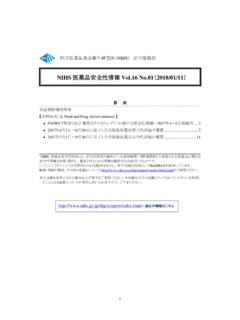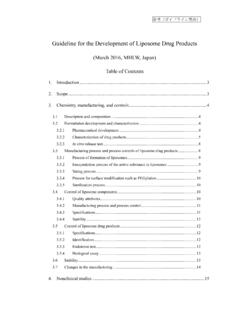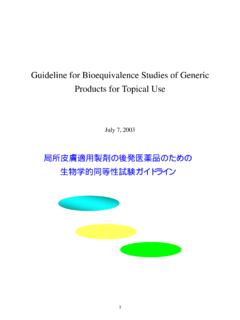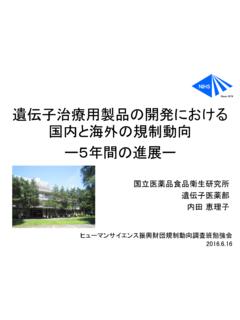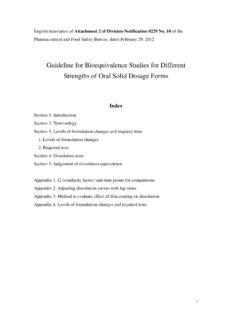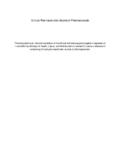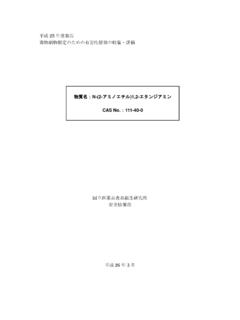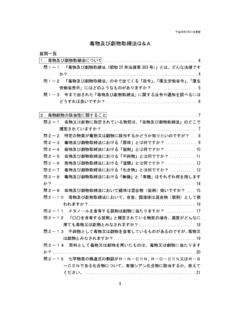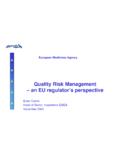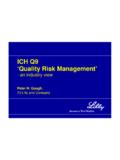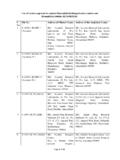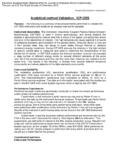Transcription of Draft Guideline on Bioanalytical Method Validation in ...
1 Draft Guideline on Bioanalytical Method Validation in pharmaceutical development 15 April 2013, MHLW, Japan) 2 Table of Contents 1. Introduction 2. Scope 3. Reference Standard 4. Analytical Method Validation Full Validation Selectivity Lower limit of quantification Calibration curve Accuracy and precision Matrix effect Recovery Carry-over Dilution integrity Stability Partial Validation Cross Validation 5. Analysis of Study Samples Validity and reproducibility of analytical Method in analysis of study samples Calibration curve QC samples Incurred samples reanalysis (ISR) Carry-over Points to note Calibration range Reanalysis Chromatogram Integration System suitability 6. Documentation and Archives List of Relevant Guidelines Glossary Annex 3 1. Introduction 1 2 In the development of medicinal products, Bioanalytical methods are used in clinical 3 and non-clinical pharmacokinetic studies (including toxicokinetic studies) to evaluate 4 the efficacy and safety of drugs and their metabolites.
2 Drug concentrations determined 5 in biological samples are used for the assessment of characteristics such as in vivo 6 pharmacokinetics (adsorption, distribution, metabolism, and excretion), bioavailability, 7 bioequivalence, and drug-drug interaction. 8 It is important that these Bioanalytical methods are well characterized throughout the 9 analytical procedures to establish their validity, reproducibility, and reliability. 10 This Guideline serves as a general guidance recommended for the Validation of 11 Bioanalytical methods to ensure adequate reproducibility and reliability. It also provides 12 a framework for analyses of study samples by using validated methods to evaluate study 13 results supporting applications for drug marketing authorization. 14 An applicable way with flexible adjustment and modification should be required in 15 case of using the specific type analytical Method or depending on the intended use of 16 the result of analysis, such as the use of prospectively defined appropriate criteria, based 17 on scientific judgment.
3 18 19 2. Scope 20 21 This Guideline is applicable to the Validation of analytical methods applied to 22 measure concentrations of drugs and their metabolites in biological samples obtained in 23 toxicokinetic studies and clinical trials, as well as to the analyses of study samples using 24 such methods . The information in this Guideline generally applies to the quantification 25 of low-molecular-weight drugs and metabolites, and to analytical methods such as 26 liquid chromatography (LC) and gas chromatography (GC) used either alone or in 27 combination with mass spectrometry (MS). 28 This Guideline is not intended for analytical methods used in non-clinical studies that 29 are beyond the scope of "Ministerial Ordinance Concerning the Standards for the 30 Conduct of Non-clinical Studies on the Safety of Drugs (Ministry of Health and Welfare 31 ordinance No. 21, dated March 26, 1997)" but could be used as a reference in 32 conducting a Method Validation .
4 33 34 3. Reference Standard 35 36 4 Reference standard serves as the standard in quantifying an analyte, and is mainly 37 used to prepare calibration standards and quality-control (QC) samples, which are 38 samples spiked with a known concentration of the analyte of interest. The quality of the 39 reference material is critical, as the quality affect measurement data. Therefore, a 40 material of known chemical structure from an authenticated source should be used as a 41 reference A certificate of analysis that provides information on lot number, 42 expiration date, content (purity), and storage conditions should accompany the standard. 43 A certificate of analysis is not necessarily required for an internal standard, but the lack 44 of analytical interference with the analyte should be demonstrated before use as the 45 internal standard. 46 47 4. Analytical Method Validation 48 49 Full Validation 50 51 A full Validation should be performed when establishing a new Bioanalytical Method 52 for quantification of an analyte.
5 A full Validation should also be considered when a new 53 analyte, such as a metabolite, is added to an existing, fully validated analytical Method . 54 A full Validation is also required when using an analytical Method that has been 55 published in the literature. 56 The objective of full Validation is to demonstrate selectivity, lower limit of 57 quantification (LLOQ), calibration curve, accuracy, precision, matrix effect, recovery, 58 carry-over, dilution integrity, and stability. Generally, a full Validation should be 59 performed for each species and matrix (mainly plasma, serum, whole blood, or urine) to 60 be analyzed. 61 The matrix used in analytical Validation should be as close as possible to the intended 62 study samples, including anticoagulant and additives. When an analytical Method is to 63 be established for a matrix of limited availability (rare matrix, , tissue, cerebrospinal 64 fluid, bile), one may encounter a problematic situation where a sufficient amount of 65 matrix cannot be obtained from an adequate number of sources (subjects or animals).
6 In 66 such a case, a surrogate matrix may be used to prepare calibration standards and QC 67 samples. However, the use of a surrogate matrix should be rigorously justtified in the 68 course of establishing the analytical Method . 69 70 Selectivity 71 72 5 Selectivity is the ability of an analytical Method to measure and differentiate the 73 analyte and the internal standard in the presence of other components in samples. 74 Selectivity is evaluated using blank samples (matrix samples processed without 75 addition of an analyte or internal standard) obtained from at least 6 individual sources. 76 The absence of interference with each analyte and internal standard should be confirmed. 77 In case the matrix is of limited availability, it may be acceptable to use matrix samples 78 obtained from less than 6 sources. 79 The evaluation should demonstrate that no response attributable to interfering 80 components is observed with the blank samples or that a response attributable to 81 interfering components is not more than 20% of the response in the lower limit of 82 quantification (LLOQ) for the analyte and 5% of the internal standard.
7 83 84 Lower limit of quantification 85 86 The lower limit of quantification (LLOQ) is the lowest concentration of an analyte at 87 which the analyte can be quantified with reliable accuracy and precision. 88 The analyte response at the LLOQ should be at least 5 times the response of a blank 89 sample. Mean accuracy and precision at the LLOQ should be within 20% of the 90 nominal (theoretical) concentration and not more than 20%, respectively. 91 92 Calibration curve 93 94 A calibration curve demonstrates the relationship between the theoretical 95 concentration and the response of the analyte. 96 A calibration curve needs to be prepared for each analyte. The calibration curve 97 should be prepared using the same matrix as the intended study samples, whenever 98 possible, by spiking the blank matrix with known concentrations of the analyte. A 99 calibration curve should be generated with a blank sample, a zero sample (blank sample 100 spiked with internal standard)), and at least 6 concentration levels of calibration 101 standards, including an LLOQ sample.
8 In general, the simplest model that adequately 102 describes the concentration-response relationship should be used for regression equation 103 and weighting conditions of the calibration curve. A multiple regression equation may 104 be used. Blank and zero samples should not be included in the determination of the 105 regression equation for the calibration curve. The Validation report should include the 106 regression equation and correlation/determination coefficient used. 107 The accuracy of back calculated concentrations of each calibration standard should be 108 6 within 20% of the theoretical concentration at the LLOQ, or 15% at all other levels. 109 At least 75% of the calibration standards, with a minimum of 6 levels, including the 110 LLOQ and the highest levels, should meet the above criteria. 111 112 Accuracy and precision 113 114 Accuracy of an analytical Method describes the degree of closeness between analyte 115 concentration determined by the Method and its theoretical concentration.
9 Precision of 116 an analytical Method describes variation between individual concentrations determined 117 in repeated measurements. 118 Accuracy and precision are assessed by performing analysis with QC samples, , 119 samples spiked with known amounts of the analyte. In the Validation , QC samples with 120 a minimum of 4 different concentrations (LLOQ and low-, mid-, and high-levels) within 121 the calibration range are prepared. The low-level should be within 3 times the LLOQ, 122 the mid-level is around the midpoint on the calibration curve, and the high-level should 123 be at least 75% of the upper limit of the calibration curve. Within-run accuracy and 124 precision should be evaluated by replicate analysis of at least 5 times at each 125 concentration level in a single analytical run. Between-run accuracy and precision 126 should be evaluated by the analysis in at least 3 analytical runs. 127 The mean accuracy at each concentration level should be within 15% of the 128 theoretical concentration, except at the LLOQ, where it should be within 20%.
10 129 Precision of concentrations determined at each level should not exceed 15%, except at 130 the LLOQ, where it should not exceed 20%. 131 132 Matrix effect 133 134 Matrix effect is an alteration of the analyte response due to matrix component(s) in 135 the sample. Matrix effect should be assessed when using mass spectrometric methods . 136 Matrix effect is evaluated by calculating the matrix factor (MF). The MF is 137 determined by comparing the analyte response in the presence of matrix with that in the 138 absence of matrix. MF should be calculated using matrix from at least 6 different 139 sources. The MF may be normalized using an internal standard. The precision of the 140 MF calculated should not exceed 15%. 141 Matrix effect can also be evaluated by analyzing QC samples, each prepared using 142 matrix from at least 6 different sources. The precision of determined concentrations 143 should not be greater than 15%.
